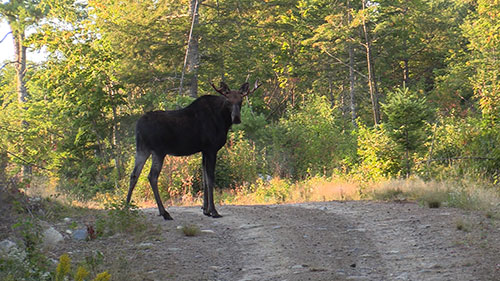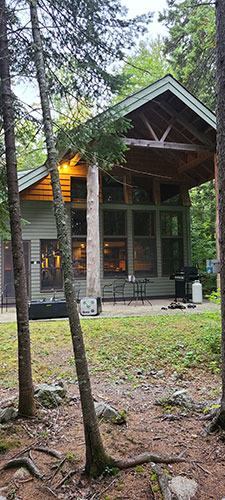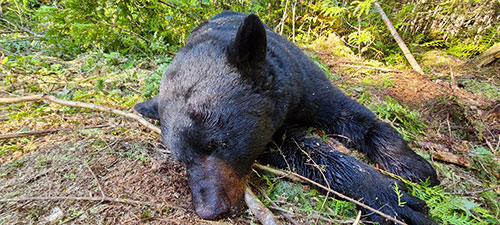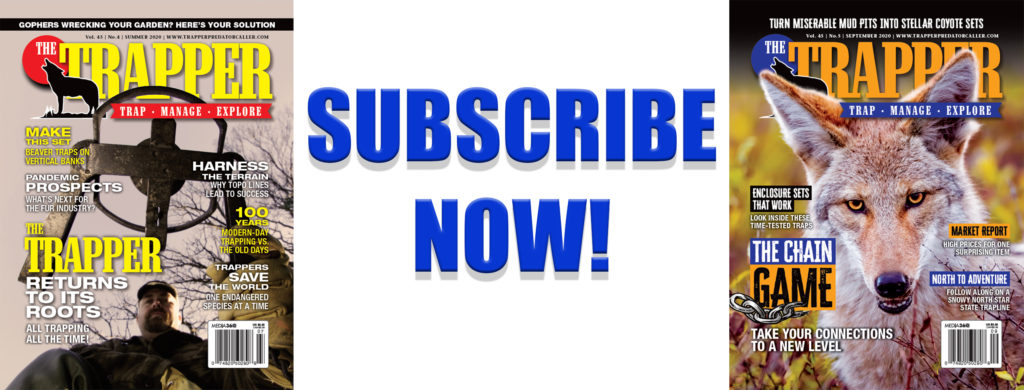Text and photos by Jason Houser
My 2020-2021 trapping season started a little different than most years. Instead of setting dogproofs for raccoons in Illinois or bobcats in South Carolina, my season started in Maine. Nope, I wasn’t going after their abundant population of beavers, otters or mink. I was going after one of their abundant black bears.
Maine is the only state in the United States where it is legal to trap bears. Both a trapping license and a bear trapping permit are required. Sure, you hear stories of bears getting caught in a coyote traps throughout the year. And as much as I have always wanted to trap a bear, I hope I never catch one in a coyote trap. I could only imagine the trouble that it would be to release an angry bear of any size.
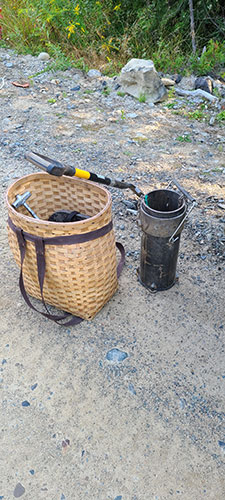
Bear trapping is no different than any other trapping — except for the gear. Photo credit Jason Houser.
After deciding in late 2019 that I wanted to go bear trapping, I began my search for a reputable guide. While searching the web for bear guides, I was a little surprised by the number of guides offering the service. More than I thought there would be. After finding a few that looked promising, I began stalking their Facebook pages to see how their 2019 season went. One guide, in particular, stood out to me. Not just for trapping, but also for hunting and their dedication to the sport, and that was Maine Whitetail Adventures located in Millinocket, Maine.
Now, stalking a Facebook page might not be the best way to narrow down a search, but I have found in the past that guides normally only hand out phone numbers to references they want you to talk to. You don’t always get the full story. When a guide makes a post about the good and bad days, you begin to get a feel for what you can expect.
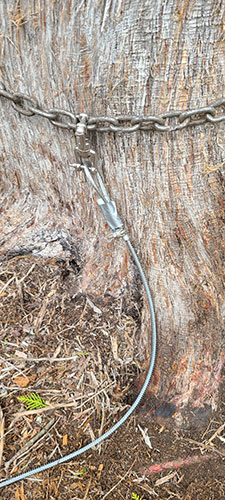
Big bears require heavy-duty chains and stakes. Photo credit Jason Houser.
Shortly after the 2019 season ended, I called Jayson Lucarelli, the owner of Maine Whitetail Adventures. Don’t let the name fool you, it is not all about whitetails. Jayson has high success hunting black bears and 100 percent success trapping them. After a couple of phone calls to learn more about his operation and what I could expect, I signed up to hunt and trap bears with him. A person can legally take two bears in Maine. One via hunting and the other trapping.
As 2020 was still in its infant stages, COVID-19 hit. Some states were canceling their spring hunting seasons, and some were restricting visitors. You know the story, and it wasn’t good. Was my trip going to be canceled?
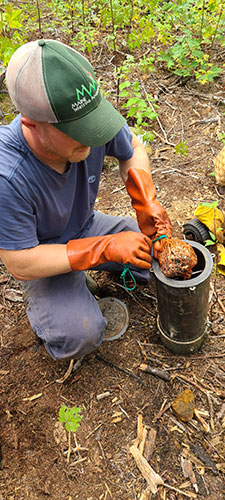
A bag of bait is tied off to the trigger in the bottom of the trap. Photo credit Jason Houser.
In the back of my mind, I worried over this hunt like none I have ever worried about before. Probably because my hopes were so high from the time I booked this trip and I didn’t want anything to ruin it. And, looking back now that it is over, I think the only thing that would have stopped me from going to Maine would have been if they refused to give me a license, or the guides refused to provide service.
As our trip drew near, the airline made enough changes that we decided to make the 24-hour drive out to Maine from our home in Illinois. It was probably for the best with everything that was going on, and a drive halfway across the country wasn’t enough to stop me from going bear trapping. And, in the end, we were thankful that we drove. The scenery was beautiful and with all of the gear we had, flying would have been impractical. Plus, if I killed a bear or two, I would have to pay to have everything shipped back home.
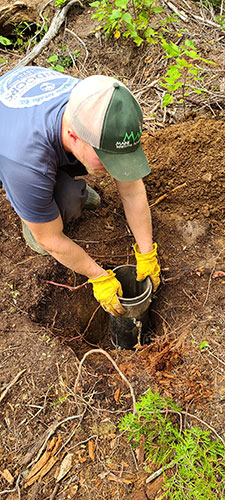
A hole must be dug for the snare to sit at or below ground level. Photo credit Jason Houser.
I use the term bear trapping, but in reality, it is bear snaring. Foot snares to be exact. The device we used was the Crit-R-Done. Imagine a dogproof on steroids. You dig a hole, place the tube in the ground that has bait tied in a bag that is attached to the trigger at the bottom of the trap. A snare is placed on the lip of the tube.
When the bear reaches down for the bait made up of cookies and pop tarts, it should pull up on the tied-off bag, the snare is pushed off the lip of the tube and hopefully, the bear is caught. That is how the trap works in a nutshell.
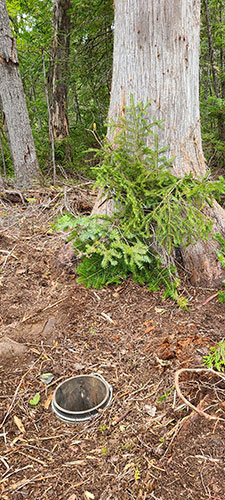
Try to blend everything in as much as possible to keep the curious bears from tearing up the set. Photo credit Jason Houser.
With our sets in place, it is normally just a matter of waiting through the night and checking the traps at first light the following morning. Even with strong snares and everything done by the book, it is still possible for a bear to pull free. Like any trapping scenario, the sooner you can check your trap the better off you will be.
The difference, though, was that I brought along a Reveal Cellular Camera from Tactacam. This camera allowed us to watch our baits in real time. The bad part of this was that as we were seeing photo after photo of bears coming through, and we knew that any minute we were going to have a bear in the trap. It quickly became three grown adults sitting on a couch waiting to catch a bear.
With our camera surveillance in place, the need to get up at the crack of dawn was off the table because we could see if we had a bear or not. It enabled us to make the drive to the trap site later in the afternoon on the way to my stand for an evening hunt.
This went on for the first two nights and even though we had a nice bear visiting the site every night, he was not committing to the set. Our recon with the cameras allowed us to piece together what we might be able to do differently to catch the bear. On the third day, we made some changes to the spring tension on the snare, as well as made some changes to the bait. We knew that it was going to happen that night.
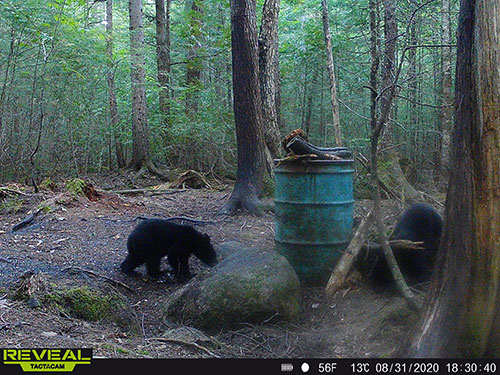
Up-to-the-minute photos of our trap site allowed us to monitor the activity for a caught bear or curious sows and cubs. Photo credit Jason Houser.
With our cameras on the job transmitting every movement, we were in for a surprise when a sow and two of her cubs showed up at the site. Jayson works hard to avoid these situations, but with bears always on the move, it is just a matter of time before a sow and her cubs would show up.
I was sitting overlooking my bait site when I received a notification of a bear at the trap. After opening the app and seeing the family of bears, I quickly sent a message to Jayson. He had already seen the pictures and was racing to the site to scare the bear family away. Even though any bear would have been legal, the ethical part of us did not want to catch the mother or a cub.
Jayson made it to the site in time and chased the bears off. The trap was pulled, and the decision was made to reset it the following day after it was cleaned thoroughly and fresh bait could be added.
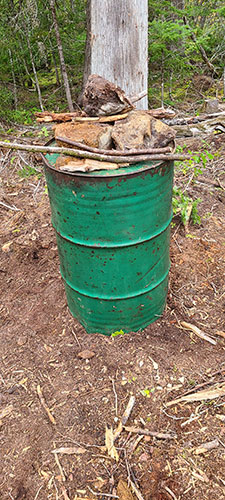
A finished set must be covered with at least 30 pounds of weight to prevent small bears and other incidental catches. Photo credit Jason Houser.
After choosing a different location, we made what looked like a perfect set. Bears had been visiting the site nightly and our intel told us that it was free of sows and cubs. Just a couple of lone boars in the area.
Throughout the night I thought my camera had stopped working. Just a couple pictures of raccoons came through. Not sure if we had a bear or not because we thought the camera shut down, so we made the drive at first light to check the trap.
Well, the camera was working fine. It was the bears that were not working. A bear had been shot from the site just a couple of days earlier so that likely explained the lack of movement that night.
We decided to pull the trap and move it for the last night to a location where our cameras showed good activity, and where I passed up a bear earlier in the week while hunting. A couple of bears quickly caught our attention. One had a white patch on its brisket and the other was a respectable bear by anyone’s standards. I would be happy with either one of them.
During the previous five days, our Reveal camera had taken thousands of photos of bears and a ton of video. As we were closing the doors of the camera we saw a low battery warning and the camera died. In the middle of nowhere, we were not going back to town for batteries. This was my fault. I had received emails of the battery being low, but I failed to act. We were just going to have to trap bear the old-fashioned way.
The good part of not having a camera out was that we were able to get a good night’s sleep without watching our phones all night. Also, this allowed for a little more excitement as we made our way to the site to check the trap, not knowing if we had a bear or not. We both had a good feeling that we would have a bear.
The following morning found us in the truck at daylight for the drive to the trap site. We made good time on the drive except we did encounter a roadblock by one of the local bull moose. After a few photos the moose finally allowed us through.
Walking through a dense forest to check a bear trap is an experience difficult to explain. Our adrenaline was flowing and our hearts were pounding with anticipation.
As we rounded the final bend in the trail, it was quickly evident that we had a bear, even though we could not see it. Trees were shaking and with no wind, only one thing could cause all that movement.
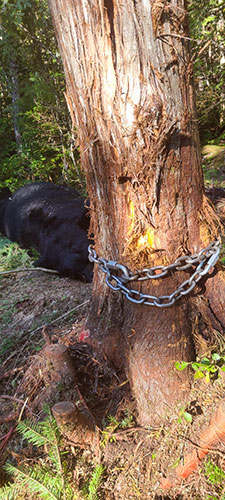
The sight of a bear after a hard week of trapping can only be summed up as unbelievable. Photo credit Jason Houser.
Still not sure what we had, we continued closer. Jayson was able to get in sight of the bear, the only thing I heard was, “That’s a big bear, really big bear.” I could not see the bear yet, but those words caused my heartbeat to go into overdrive.
When I was finally able to lay eyes on the beast, the first thing I noticed was its head. I have hunted bears before and have seen plenty of them. But nothing like I was witnessing then. Imagine two basketballs side by side. That is what the head of this bear looked like.
Knowing that we had to move fast in case part of the snare gave and the bear was able to free itself, I got into a good position to dispatch the bear. With my nerves somewhat settled, I was able to put the beast down for good.
Seeing the bear take its last breath and hearing the unmistakable sound of death allowed me to appreciate this magnificent animal all the more. More than once we gave thanks to this bear and the opportunity to pursue it on its terms.
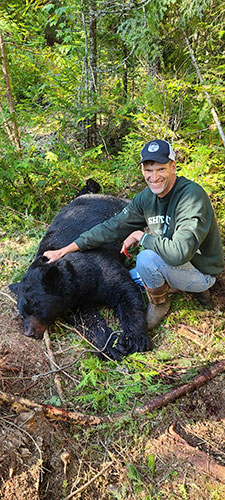
The author with his bear that dressed at 386 pounds, and had an estimated live weight of 468 pounds. Photo credit Jayson Lucarelli.
Everything worked as it was supposed to. You better have tough gear when trapping bears. You never know what you might catch. The snare caught the bear between his wrist and elbow, just as it was intended to do. The chances of this bear escaping were extremely low, but you just never know. It’s trapping, after all.
With warm weather expected, we made quick work of getting the bear field-dressed. The RazorBone from Outdoor Edge Knives worked flawlessly on the giant bear and in no time we were figuring out how to get the bear out. Estimated to field-dress at 300 pounds, we knew we had our work cut out for us.
We were only 200 yards from the truck, but we might as well have been two miles. It was not an easy drag. With brute force, we were able to get the bear to the road and into the bed of the truck. In the end, the two of us were worn out, but extremely excited to have the bear loaded up.
We knew we were hauling something special on the way to the check-in station. We both called our wives and had them meet us in town. We wanted them to be part of the celebration.
After the bear was properly tagged, it was time to weigh it. We guessed him to be 300 pounds dressed. But as the bear came out of the truck and we hit the 325-pound mark, 350, then 375 we could not believe what we were seeing. In the end, the bear tipped the scales at 386 pounds dressed.
As I sit here writing this article, I am struggling to find the words to describe the ups and downs of the entire week and trapping the bear of a lifetime. The only word that comes to mind now and the word I muttered over and over that day is unbelievable.
Bear trapping might not be for everyone, but if you’re interested in it — all I can say is go do it. It is a memory that will be with me until I take my last breath. I can’t thank Jayson with Maine Whitetail Adventures enough for all of the hard work he put in during the months leading up to this trip. Truly a first-class operation with great accommodations and fabulous meals that his wife Jesika prepared every night. It all paid off in the end. Unbelievable!
Maine Department of Inland Fisheries & Wildlife
Design Standards for All Cable Traps Used to Capture Black Bears
Whenever a cable trap is used to trap for bear:
• The cable must have a minimum closing diameter of not less than 2½ inches
• The cable must be at least 3/16 inch in diameter
• The cable must include at least one swivel, which is typically located between the foot loop and the anchor point
Deployment Standards for ALL Cable Traps Used
to Capture Black Bears
• The cable must be set at or below ground level in such a manner as to catch the animal only by the foot or leg.
• Drags are prohibited.
• The cable must be securely attached to a fixed anchor point.
• If a tree is used as an anchor, it must be at least 6 inches in diameter at 4.5 feet above ground level and must be free of limbs for at least 7 feet above the ground.
• The catch circle, which is the distance from the anchor to the end of the closed cable loop, must be no greater than 8 feet.
• The area within the catch circle must be clear of woody vegetation, debris, and manmade material that could cause entanglement of a trapped bear. This restriction does not include a tree used as an anchor. Sticks and rocks and rotten/decaying woody material may be used for stepping guides, blocking, and backing for trap sets, if they are not rooted to the ground.
Maine Department of Inland Fisheries & Wildlife
Design Standards for Bucket, Tube, or Pipe-style Traps Used to Capture Black Bears
Whenever a cable trap is used in conjunction with a device that is designed to capture a bear when it reaches into the device to obtain bait (e.g. bucket, tube, or pipe-style traps):
• The trigger must be recessed at least 12 inches below the opening of the device.
• The opening and inside diameter of the device must be no more than 6 inches.
• A bucket or other similar device can be used if it is modified to have an opening and inside diameter no greater than 6 inches.
Deployment Standards for Bucket, Tube or
Pipe-style Traps Used to Capture Black Bears
• Animal-based bait and/or lure cannot be placed within the bucket, tube or pipe. Animal-based bait is defined as animal matter including meat, skin, bones, feathers, hair or any other solid substance that used to be part of an animal. This includes live or dead fish.
• Only non-animal based bait and/or lure can be placed within the device and it must be placed below the trigger.
• The opening to the device must be covered by a weight of at least 30 pounds when set, placed, and tended to prevent access by non-target species.
— Courtesy Maine Department of Inland Fisheries & Wildlife
